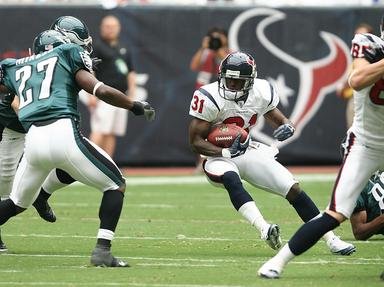Quiz Answer Key and Fun Facts
1. In 1920, the Akron Pros and Buffalo All-Americans got together to make the biggest trade in NFL history up to that point, even though it only included one player. Who did Buffalo receive from Akron in the first known trade in NFL history?
2. On March 26, 1953, the Cleveland Browns and Baltimore Colts got together for the largest trade in the NFL at that point in time. Four Pro Bowlers were included in the deal that sent Mike McCormack, Don Colo, Tom Catlin, John Petitbon, and Herschell Forester to Cleveland, and Bert Rechichar, Art Spinney, Carl Taseff, Ed Sharkey, Gern Nagler, Harry Agganis, Dick Batten, Stu Sheets, Elmer Willhoite, and this future Hall of Famer (albeit as a coach) to Baltimore.
3. March 23, 1959, brought together two teams that would eventually move out of their respective cities. The Los Angeles Rams had no problems giving up 8 players; Ken Panfil, John Tracey, Frank Fuller, Glenn Holtzman, Art Hauser, Larry Hickman, Don Brown, and a player to be delivered in training camp (2 of them Pro Bowlers), and a Round 2 draft pick (eventually Harold Olson, who made a Pro Bowl) for what 5-time Pro Bowl running back from the Chicago Cardinals?
4. The Baltimore Colts knew well before May 1, 1984, that they would have to make a trade on that day, but they weren't sure with who it would be. It ended up that they would be swapping with the Denver Broncos in one of the first known forced draft day trades. The Colts sent which future Hall of Famer to Denver for Mark Herrmann, Chris Hinton, and a 1984 round 1 pick (eventually Ron Solt)?
5. On April 28, 1987, the Tampa Bay Buccaneers and San Francisco 49ers made what was eventually one of the most lopsided draft day trades in NFL history. Tampa Bay received second and fourth round picks in the 1987 draft, eventually Winston Moss and Bruce Hill, for what future Hall of Fame quarterback, then labeled a bust for the Bucs?
6. On Halloween of 1987, 3 teams got together to make a 10-player deal. Initially it seemed that the Los Angeles Rams got the upper hand, receiving Pro Bowler Greg Bell, Owen Gill, and 6 draft picks (eventually Gaston Green, Cleveland Gary, Darryl Henley, Aaron Cox, Fred Strickland, and Frank Stams) from Buffalo and Indianapolis. Buffalo only received the rights to Cornelius Bennett, a future 5-time Pro Bowler. However, Indianapolis received what future Hall of Fame running back, who would rush for over 1000 yards in a mere 9 games for the Colts in 1987?
7. On April 17, 1999, during the 1999 NFL Draft, perhaps the most confusing of all NFL trades ever made took place. In his third year as coach of New Orleans, Mike Ditka traded away every single pick the Saints had, along with picks from rounds 1 and 3 of the 2000 draft to the Washington Redskins and the Chicago Bears. Notables from those picks are Champ Bailey for the Redskins, and Marty Booker and Jerry Azumah for the Bears. What Pro Bowl running back did New Orleans give up their entire 1999 draft for?
8. On April 18, 1998, the San Diego Chargers and Arizona Cardinals couldn't decide on who should draft a bigger NFL bust. The Chargers decided to take the initiative, sending 3 draft picks and 3-time Pro Bowler Eric Metcalf for the #2 pick in the 1998 draft. Arizona would waste their first pick on defensive end bust Andre Wadsworth, but then drafted 2 Pro Bowlers in Corey Chavous and David Boston. Who did San Diego receive in this trade, deemed one of the biggest NFL busts of all-time?
9. Following in the steps of John Elway, Eli Manning forced the San Diego Chargers into a deal on April 24, 2004, the first day of the 2004 NFL Draft. Manning refused to sign with the Chargers, and so after drafting him first overall, promptly traded him away to the New York Giants. In return, the Chargers received the rights to Philip Rivers and 3 draft picks. One of those picks was traded away, but the other two players picked would be Pro Bowlers along with Rivers. Nate Kaeding was chosen later in the 2004 draft, but what 2005 NFL Defensive Rookie of the Year did San Diego choose with New York's 1st pick in the 2005 draft?
10. On October 13, 1989, the Minnesota Vikings, Dallas Cowboys, and San Diego Chargers got together to put together what was at that time the largest trade ever made. The Chargers simply received Darrin Nelson from the Vikings through the Cowboys. However, the Cowboys got Jesse Solomon, David Howard, Isaac Holt, Alex Stewart, and 8 draft picks which included the 1990 pick that would end up being Hall of Fame running back Emmitt Smith from the Vikings. In return, the Vikings received a draft pick from the Chargers, 3 more picks from Dallas, and a 2-time Pro Bowl running back that would never break 1000 yards in Minnesota. Who was this back that the Vikings were so desperate to get?
Source: Author
illiniman14
This quiz was reviewed by FunTrivia editor
Nightmare before going online.
Any errors found in FunTrivia content are routinely corrected through our feedback system.
